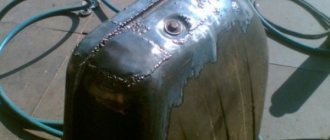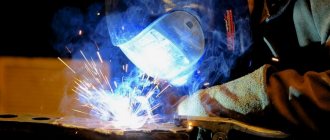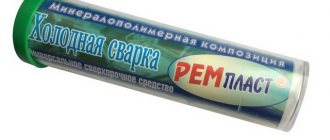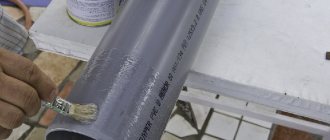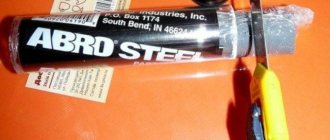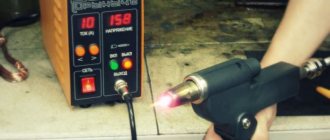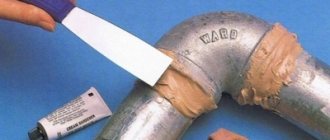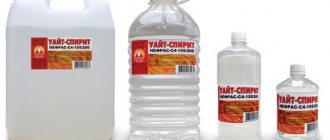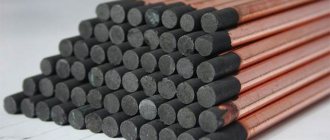Welding with linoleum
"Cold welding" or "Fast steel" are allowed for . They consist of the following substances: tetrahydrofuran; plasticizers; polyvinyl chloride The composition allows you to somewhat straighten the edges of the glued linoleum using the prepared mass. The main feature of this type of welding is the difference in its behavior during the work and in contact with different types and brands of linoleum. Manufacturers recommend three main types of adhesive components:
Type A glue
It is used when it is necessary to join the seams of a fairly hard material. The consistency of linoleum glue is characterized by significant fluidity. When working, you get a fairly thin, neat seam.
Type "C"
This cold steel is suitable for linoleum, which has been in use for a relatively long time, has a high degree of wear and is subject to cosmetic repairs. The consistency of the adhesive mixture is thicker than “A”. This determines the specifics and scope of its use. As a result of the work, the seam is filled. It fills the gap between the old strips of linoleum. A visible new strip of adhesive will form at the bonding site.
Type "T" glue
This type is designed for cold welding of linoleum. The building material is made of PVC. Polyester is used. The composition of type T adhesive for linoleum is specified in the product modification. It is used more often by professionals and builders.
Expert advice
Experts recommend performing plastic repairs with extreme precision and reliability when correcting problems with pipes. This process requires a water-resistant mixture that will withstand constant exposure to liquids. The surfaces must be dried before application, which will increase adhesion. When repairing a leak in a plastic water pipe, you need to understand that this repair is temporary and you need to think about a major repair of the breakdown.
If the part to be glued is constantly exposed to vibration, then an additional pad should be applied to the joint.
You should not buy material that has expired. This will significantly reduce the performance of the seam on plastic.
We recommend watching the video:
Working with cold welding
Adhesive for joining metal parts is very popular primarily due to the fact that to work with it you do not need to have any welding skills and there is no need to purchase special equipment. Anyone can do this job. You just need to study the instructions in detail.
So, to work with metal glue you will need:
- welding glue;
- clamps (if necessary);
- degreaser (acetone);
- sandpaper.
Description of cold welding:
- First you need to prepare the surfaces of the parts to be glued. They must be cleaned with sandpaper and degreased. Surfaces must be dry and rough for better adhesion to the glue. The final result of the work depends on how well the preparation is done. Therefore, take this stage seriously.
- Many compounds easily stick to your hands, which can ultimately disrupt the proportions of the adhesive components. To prevent this from happening, wet your hands with water.
- Two-component adhesive must be mixed with a hardener. If it is a solid plasticine-like glue, then it should be thoroughly kneaded with your hands, the liquid glue is mixed with the hardener in the proportion specified in the instructions. When mixed, the composition tends to heat up.
- After mixing, you need to work with the glue quickly - no more than 3 minutes.
- When connecting two flat surfaces, secure them with special clamps to ensure a secure fit.
- Dry welding can take anywhere from 1 to 8 hours to dry, depending on the type and manufacturer. After this, the repaired part can be puttyed and painted.
- Do not violate the instructions for using glue, otherwise the strength of the weld will decrease.
There are now many adhesive mixtures and adhesive sticks on the market under the general trade name “Cold Welding” or “Fast Steel”
. In fact, they have nothing to do with welding because:
Cold welding pressure welding with significant plastic deformation without external heating of the parts being connected
This is not cold welding
because There is no plastic deformation of the connected parts.
Welding is the process of obtaining permanent connections of parts by establishing interatomic bonds between the parts being welded during their local (general) heating or plastic deformation, or the combined action of both
This is not welding
, since there is no heating or plastic deformation, much less the establishment of interatomic bonds between the connected parts.
In this article we will take a closer look at the Cold Welding adhesive and rods.
"Cold welding"
are composite polymer materials used both for the repair of metals (steel, cast iron, aluminum, copper, titanium, etc.) and for the repair of wood, plastic and ceramic products.
Adhesive "Cold welding"
two-component and comes in two tubes:
- epoxy resin with plasticizer and filler
- hardener
Figure 1 – Two-component adhesive
Epoxy resins in their pure form are fragile and do not withstand vibrations and shock loads well, which is why a plasticizer
(component for increasing the elasticity of epoxy resin).
The filler
is necessary to impart special properties to epoxy resins: thermal conductivity, heat resistance, abrasion resistance, etc. Depending on the required properties of “cold welding”, metal powders (aluminum, steel, cast iron, etc.) as well as mineral and artificial fillers are used as fillers.
As a hardener
They mainly use polyethylene polyamine or an amine hardener, which reacts chemically with the epoxy resin to produce a hardening process.
The mechanical properties, hardening time, operating temperature and scope of application of cold welding adhesive depend on the components included in its composition.
Below are generalized instructions for cold welding glue and putty, which may vary depending on the brand and manufacturer:
Basic operating principles
It is prohibited to combine liquid substances consisting of two components directly on the treated area. To do this, use a special vessel, which subsequently will not contain food.
In order not to damage the excess material, it is necessary to cut out part of the required volume from it, and the remainder is hermetically sealed and left for storage in a cool room.
In order for the adhesion force of welding and coating to be maximum, it is necessary to carefully carry out preliminary preparation, mainly to remove fat from the base.
There are times when it is necessary to remove the old weld before applying a new one.
It is recommended to clean products mechanically - with a file or chisel. Then it is necessary to treat the product with white spirit or acetone and carry out a new welding.
Almaz cold welding classification
Cold welding of the Almaz-Press series has high adhesion rates with various materials (wood, metals, ceramics, plastic, etc.). The manufacturer produces the following types within the series:
- "Universal". Suitable for joining metal and non-metal parts and products. Can be used for repair work in hard-to-reach places.
- "For woodworking." The composition allows you to firmly connect and fix various types of wood, plywood, veneer, bars and other wooden materials. Can be used for repair and restoration work on furniture. Has a natural wood tone.
- "For plumbing repairs." Used to restore ceramics, earthenware, porcelain and other materials from which plumbing fixtures and decorative elements are made. It has a white tint, which allows you to hide the places where repair work is being carried out.
- "To repair a car." Used for sealing cracks, eliminating chips, restoring threads, sealing various surfaces, and fixing decorative elements on car surfaces.
- "With steel filling." This type of Almaz cold welding contains steel filler. The substance is used for gluing metal products (cast iron, steel, copper, aluminum and other types of ferrous and non-ferrous metals).
general information
Almaz cold welding is produced in polymer cylindrical tubes. The glue is additionally protected by cellophane. The manufacturer produces tubes of different sizes for consumer convenience.
Application area
Cold welding "Almaz" according to the instructions has the following scope of use:
- Connecting wooden, ceramic, plastic, concrete, glass, metal parts.
- Connection of products, parts and surfaces made from different materials.
- Elimination of leaks in pipelines, containers, tanks.
- Repair of garden and sports equipment.
- Repairs in hard-to-reach areas or when it is impossible to dismantle or disassemble equipment and structures.
Application area
Plastic refers to synthetic polymer materials .
It is widely used in various industries, science, and everyday life. The wider the scope of application of polymers, the greater the demand for methods of its repair. Currently, cold welding for plastic is successfully used to repair the following materials:
- plastic piping and plumbing;
- internal and external plastic of the car: bumpers, door cards;
- housing and parts of household appliances;
- plastic products;
- linoleum and other flooring.
- fishing gear.
Advantages and disadvantages of "Poxipol"
The popularity of this brand of glue is due to its excellent adhesive properties. The seam is durable and does not collapse over time. The advantages of "Poxipol" are:
- preservation of the volume of the seam after drying, the possibility of applying an adhesive layer of any thickness;
- the use of glue on any materials (even those of different structure and density), no damage or corrosion when applied to most types of plastic;
- water resistance, oil resistance, scratch resistance;
- possibility of application to vertical and horizontal substrates using continuous and spot methods;
- ease of mixing and ease of application;
- quick setting and short time until complete curing;
- Possibility of use for interior and exterior work;
- absence of solvents in the composition, possibility of use in residential premises, children's institutions;
- absence of traces, stains, drips after drying;
- availability for sale in almost all hardware and construction stores;
- simplicity and clarity of instructions for use.
The disadvantages of Poxipol glue include its low tensile strength. Therefore, you should not use glue in conditions where parts are subject to vibration, other movement, deformation, or high mechanical loads. The quality of gluing decreases if the surface is not prepared correctly, which can also be considered a disadvantage of the glue. Another disadvantage is the risk of damage to some materials (Teflon, polypropylene, polyethylene); this glue cannot be used on them. Other disadvantages:
- higher price compared to domestic adhesives;
- low melting point;
- short pot life of the glue after dilution;
- the need to mix components;
- packaging is too small (if there is a large amount of work to be done).
Safety at work
According to the instructions for use, when using liquid welding, the following rules are observed:
- Avoid contact of the product with the skin. It is recommended to work in a special suit and gloves. In case of accidental contact with glue, the skin is thoroughly washed with water and, if necessary, consult a doctor.
- The connection of plastic parts is carried out in a well-ventilated area. To protect the respiratory system, wear a respirator.
- Do not use glue for repairing products in contact with food and drinking water.
- When working, do not leave the product in places exposed to direct sunlight.
- The dried mass is heated near the battery for 30 minutes.
The finished weld does not emit toxic fumes, so the repaired product can be used for household purposes.
Welding description
Cold welding refers to the treatment with polymer glue, which helps create reliable seams between the same or different materials without the use of heat. As a result, an integral connection of the elements is achieved, this is facilitated by the special composition of the chemical mass. The plastic agent penetrates into the parts being welded, then hardens, forming a monolithic joint.
Cold welding includes the following main components:
- epoxy resin;
- amine resins;
- steel fillers;
- minerals.
Epoxy glue is great for plastic, metal, wood, but you need to study the instructions in detail. Universal compounds can indeed be used on any material; highly specialized ones are only allowed to glue one type of element, otherwise the work efficiency will decrease.
Advantages of Almaz cold welding
What explains the popularity of Almaz glue - of course, its ease of use; in order to use cold welding you do not need any additional knowledge or tools. Almaz glue is universal, so it can be used in almost all everyday conditions, from gluing metal and wood to joining glass and plastic.
A distinctive feature of cold welding is the possibility of gluing non-homogeneous materials. “Diamond” can easily connect, for example, metal with wood or glass with rubber. This glue is available in packages of different sizes and is sold at an affordable price. The shelf life of the substance is very long and it does not require any special storage conditions. Another good advantage is that it can be used over a relatively wide temperature range. It is very easy to maintain the required setting for the glue to harden.
Flaws
The main and most important disadvantage of Almaz glue is its low quality, compared to analogues produced abroad. The material in a dried state has a very increased fragility. Almaz cold welding cannot be used in critical joints, because their tensile strength will be very low. This glue is primarily used for repairing small household items and decorative items. Lumps are also a major problem.
When mixing the material, lumps form in the consistency, which negatively affect the properties of the glue, and accordingly the quality of the connection. The outer layer does not have a very good property; when it comes into contact with dry surfaces of various kinds, it begins to stick to them. When using repaired products in unfavorable conditions, the service life of the connection is quite short.
Application area
“Diamond” cold welding is an epoxy-based adhesive. Most often it is used when it is necessary to connect any objects for which there is no alternative means for gluing. This substance can also be used to repair broken ceramic products. If any fragment has been lost, cold welding can easily replace it.
Almaz glue can connect parts made of metal, plastic, glass, wood (the parts do not have to be from the same material). However, in order for the connection of the above materials to be good, it is necessary to carry out a number of preliminary works before the gluing process. Namely, you need to thoroughly clean both bonded surfaces from various types of contaminants (traces of grease, oils, etc.). Any solvent can help with this without any problems.
One of the main features of glue is its ability to repair holes. That is, if an object breaks and a hole appears in it, cold welding can seal this hole and provide a sufficiently strong connection. In order to seal a hole, it is necessary to apply a thin layer of the substance to the surface of the hole; after the mass hardens, a durable layer is formed. Once cured, the area can be treated (sanded, painted, polished, etc.).
In a similar way, using cold welding, you can restore small lost parts; to do this, you need to give the mass the shape of the required part, as if using plasticine. After the resulting part has dried, high loads should not be placed on it. Therefore, cold welding is very rarely used in various industries. Universal adhesive "Diamond" can only be used in normal temperature conditions. It is not able to perform its functions at extremely high and low temperatures and in extreme climates.
In order for cold welding to perform its functions, it is necessary to strictly follow the instructions for use
It is important to know: after joining the parts to be glued together, it is imperative to maintain the time specified in the instructions, since only after this period the process of complete drying of the joint occurs
Where is it used?
You can repair the connector of a household appliance, repair individual elements, eliminate defects and chips.
These properties are used for cosmetic and full repair of such products:
- plastic heating pipes;
- fishing rods, travel equipment;
- plastic insulation on electrical wiring;
- housings and accessories of household devices;
- car bumpers, plastic interior elements;
- garden, household or household utensils.
Roller cold welding
This is one of the varieties of cold welding. A technique that involves the monolithic connection of workpieces due to the impact of rollers on them. Since there are rollers on both sides, the metal is completely immersed in the working protrusion.
The rollers are constantly moving and the product is moving. Working protrusions ensure uniform deformation and fastening of the material. As a result of such actions, a monolithic seam is formed.
A great way if necessary:
- produce a large number of identical metal parts;
- use in various branches of electrical engineering.
For work, manual machines or milling machines are used. What exactly – a machine or a cutter – depends on the metal being processed and the rules for working with it.
What to look for when choosing
- You should definitely read the instructions to know exactly in what cases and for what materials to use.
- When using glue, the filler must match the type of metal surface being restored.
- The expiration date is not so important, but it is better to buy a product that is not expired.
- See what temperature cold welding can withstand, working and maximum range limits.
- Time for complete curing and immediate work in contact with the adhesive.
- Store consultants often give the right advice. Buying welding from a popular brand, a proven idea is to read the reviews. If previously they were wary or used incorrectly, now there are a lot of recommendations on this topic.
Disadvantages of Mastix
- The drying time is a little higher than other brands, so there may be some problems when working with it at different temperatures;
- During preparation, lumps may form, which reduces the quality of the connection and may lead to the need for rework.
Application area
Mastix cold welding for metal is used both at home and in various professional repair procedures, depending on the type of material. It is mainly used as ordinary glue, which should connect metal, wood, plastic, stone and other things that are difficult to glue
An equally important function is the repair of pipelines, various containers, car parts and other things. By applying a plastic mass, cracks can be sealed, penetrating into the internal parts
Cold welding Mastix for metal
If the product is not used at temperatures above 150 degrees Celsius, then it can repair chips, restore parts and perform other repair procedures. The main thing is to withstand the time it takes for the cold weld to dry, after which you can put the part into operation. The strength properties here are not so strong as to withstand strong impacts, but vibration loads, which are often found in moving mechanisms, are tolerated quite normally.
Compound:
- Mineral fillers;
- Metal fillers;
- Amine resin;
- Epoxy resin.
Kinds
For metal – it has a metal filler in its composition, which improves the quality of connection with metal surfaces. It tolerates contact with moisture well, so it can be used in plumbing repairs. It is not highly sensitive to surface cleanliness, so it can be used with wet and oily parts.
Cold welding Mastix for metal welding
Universal - the mixture is used for quick repair of any surfaces. Has a wide range of operating temperatures. This is the most popular and frequently used option that may be needed in every home.
Universal cold welding Mastix
Heat-resistant - this cold welding has the highest destruction temperature, which is 250 degrees Celsius. It is used to join metals, both ferrous and non-ferrous, used in thermally active applications.
Heat Resistant Cold Welding Mastix
For plumbing – glue is used for working in damp conditions. Most often, this is a plumbing repair that requires high moisture resistance and the ability to withstand work under pressure. Connects metal, porcelain, can be used to restore carvings, and so on.
Cold welding Mastix for welding plumbing fixtures
Cold welding Mastix fast steel - contains a steel filler, which improves the quality of the connection and the restoration of lost elements with steel.
Cold welding fast steel Mastix
Mastix cold welding for aluminum – contains aluminum filler, which makes the connection to this metal stronger.
Cold Welding Mastix for Aluminum Welding
Properties and characteristics of Mastix
Before using Mastix cold welding, you should study its characteristics:
| Parameter | Parameter value |
| Package weight | 55 grams |
| Minimum operating temperature | -60 degrees Celsius |
| Maximum operating temperature | +150-250 degrees Celsius |
| Storage temperature | up to +30 degrees Celsius |
| Drying start time | from 7 minutes |
Features of use
Instructions for use of Mastix cold welding require adherence to all rules. At the initial stage, you need to clean the surface on which you will work.
After this, you need to cut off the part that you will use from the total mass. Here it should be taken into account that both components are equal. After this comes kneading and application to the surface. Next, you need to wait from 20 minutes to an hour for everything to set securely.
Choice of composition and best brands
When purchasing a material, pay attention to the performance characteristics. The welded joint must withstand heat and mechanical stress. For large volumes of work, choose durable and quickly setting types of glue.
Cold welding for plastic is subject to less stringent requirements than means for repairing metal products.
The compositions of the following brands are considered the best:
- Poxipol. A universal two-component adhesive is used to join parts made of different materials. The product is supplied in 2 tubes placed in a cardboard box. It can be used to repair structures located on the street. Work at negative temperatures is allowed. In this case, the hardening time increases. Cold welding does not spread or wrinkle. It does not contain solvents, so it does not pose a danger to humans.
- Tytan. The welding agent consists of epoxy resin reinforced with plasticizers and hardeners. Hardening time does not exceed 30 minutes. You can start using the part in an hour. Operating temperature range – -60…+130 °C. Titanium welding is used in the repair of technical equipment, mechanisms and structures used at high temperatures.
- Mastix waterproof glue. The multicomponent product contains epoxy polymers, fillers, plasticizers, and hardeners. When spreading the glue in a thin layer, the setting time is 7 minutes. Operating temperature range – -60…+200 °C. Welding firmly connects not only plastic but also metal parts.
Cold welding grades.
Review of foreign manufacturers
There is a large selection of completely different adhesive welding products on the market, and not all of them are of good quality. In this regard, we have compiled a list of products from both foreign and domestic manufacturers. The most practical options that are loved by customers have been selected. Let's start with foreign ones.
Poxipol
Price ~ 400 rubles.
An excellent two-component product, time-tested. Available in two colors: transparent and regular. The price of this product varies depending on the volume, small packages cost from 380 rubles, and large ones from 800.
Poxipol is intended for gluing metal, concrete, earthenware, wood, marble, plastic, glass, reinforced concrete, fiber cement, ceramics, granite and porcelain. After complete cooling, the weld can be drilled, sanded and even carved. By the way, it cools down very quickly; initial drying occurs after 10 minutes from the start of work. The seams are durable.
This glue is two-component, you need to mix it yourself. Manufacturers took care of the convenience of their customers by including self-cleaning mixing trays in the packaging. If there is any product left on the tray, it can be easily removed.
DONE DEAL
Price ~ 400 rubles.
DONE DEAL is a two-component adhesive designed for car repairs. Its heat resistance ranges from -55°C to +150°C, which makes it possible to weld heating parts. This adhesive also allows welding on cast iron, aluminum alloys and non-ferrous metals. The seams are very strong and durable. You need to work quickly with this weld because it dries within the first five minutes.
Abro
Price ~ from 200 rubles.
Abro is the representative of dry cold welding. Bonds a number of materials, such as metal, wood, glass, plastic, ceramics. Due to its ability to retain its properties at a temperature of 260℃, it is suitable for the repair of: gas tanks, radiators, mufflers, battery housings, oil pans, cylinder heads, body and body parts.
Abro has a peculiarity: when it hardens in time, it increases its volume, resulting in a cork effect. Thanks to this ability, this glue is suitable for repairing barrels and water pipes. It can also work underwater.
Adhesive for linoleum Linocol
Price ~ 300 rubles.
Linocol welding is suitable for filling gaps in PVC floor and wall coverings. Allows you to fasten materials at a distance from less than 1 mm to 4 mm. Usually sold in a volume of 50 ml, this is enough for 15-20 meters. Within one minute it sets, and after 6 hours the seam will be completely ready. This welding is immediately ready for use, it is presented in the form of a homogeneous mass.
The kit does not include a metal needle-shaped attachment, so to work with a narrow joint line you will need to purchase one yourself.
Weicon
Price ~650 rubles.
Incredibly strong and durable adhesive. Available in the form of a stick of welding compound. Its technical characteristics cannot but rejoice. Works at temperatures from -50℃ to 300℃. The finished seam is resistant to esters, salt water, various oils, and most acids and alkalis. It hardens and adheres to the material very quickly, initial drying occurs within 5 minutes.
It is not universal; a special stick is made for each material. The range includes cold welding for steel, copper, stainless steel, aluminum, plastic, concrete and for eliminating leaks.
Werner Muller
Price ~ 725 rubles.
The German company Werner Muller produces adhesives for the repair of PVC floor coverings. There are three types of welding to choose from (type A, type C, type T), depending on the width of the space between the pieces of material and coating; how to choose a welding mixture is described above.
A tube of this product holds 44 grams of adhesive. Cold welding from Werner Muller evens out the height of the edges, ensures optimal insertion along the seam and prevents strong absorption of the product, but do not forget to apply the tape before welding.
Selection rules
When choosing adhesive for plastic, you need to pay attention to the following criteria:
- Operating temperature. If the item will be used in extreme conditions, the adhesive seam must withstand both high and low temperatures.
- Permissible pressure on the seam. The indicator is indicated on the packaging by the manufacturer. If the glued plastic is subjected to higher loads than allowed by the instructions, the connection will break.
- Freezing time. If the item needs to be repaired for a long time, the gluing mixture must have a long hardening time. For gluing small parts, 3-5 minutes per coupling is enough.
- Release form. For gluing thin plastic elements, it is better to use a liquid substance, and it is more convenient to carry out rough work using thick plasticine-like welds.
Application of cold welding for metal
For the product to be effective, it is not enough just to apply it to the surface. Follow certain rules. Details are below.
How to work with this glue:
- Prepare the surface for work. Take sanding plaster and remove layers of dirt and rust. The larger and deeper the scratches, the better. There is a high probability that the connection will be reliable.
- Dry thoroughly. Use regular glue. Need a dry surface.
- Perform degreasing. Use acetone. It will remove even minor grease stains.
- Prepare the adhesive composition. Take a knife and cut across the cylinder. Be careful to maintain the original proportions in the resulting piece. Mash the piece thoroughly until it becomes soft and uniform in color. Wet the product with water and then the mass will not remain on your hands.
- Apply the mixture quickly to your work surface as it hardens quickly. Therefore, you need to do everything clearly and quickly the first time. If you need to seal a hole with this mass, try to ensure that part of the mass goes inside.
- Leave the repair surface for a day so that it has time to dry. And only after the period has passed, you can perform the following actions - stripping, puttying, painting.
Application:
- With a high probability of high internal stresses;
- The products are large in size;
- There is a risk of fluctuations.
To perform cold welding you need to have certain equipment that is used to make a high-strength monolithic connection. This method can be used to connect any metals to each other. A particular advantage of working with this method is the connection of materials that cannot be heated. You can weld almost any metal, even low-plasticity.
Separately about specific cases
In some situations, when using liquid welding, additional steps are required.
PVC pipes
Damage to plastic elements of a water supply or heating system is not uncommon. To quickly eliminate a leak, use the cold welding method.
Repairs are performed as follows:
- Prepare the surface for processing. Remove particles of moisture, dust and dirt.
- The amount of edge deviation is calculated. For a pipe with a diameter of 4 cm, this parameter should not exceed 2 mm.
- Cover the defect with a dry compound. Apply a fixing tourniquet to the connection. If all actions are performed correctly, the leak will disappear.
This measure is temporary; it only postpones the procedure for replacing the damaged element with a new pipe.
Preparing the surface for welding.
Floor linoleum
To glue sheets of this material, perform the following steps:
- Lay the elements overlapping on the floor. Using a metal ruler and a construction knife, cut through both sheets. If the overlap width is 10 cm, the cut line should be 5 cm away from the edge.
- Remove scraps of canvas. There should be an even joint.
- The canvases are folded back. If the material is not secured, the joint is glued with double-sided tape. It is recommended to work with a partner during these stages. First, the tape is glued to the floor and removed from the protective film. Linoleum is laid on top. Roll the joint with a roller.
- Wipe and dry the areas of linoleum adjacent to the joint. Tape the joint with masking tape. It is also rolled in with a roller. If the preparatory steps are carried out correctly, liquid welding does not fall on the surface of the floor covering.
- Cut the masking tape along the connection line. This will allow you to carefully apply liquid welding to the joint.
- Shake the bottle with the welding agent and clean the tip of any dirt.
- Distribute the glue. To do this, the tip is inserted into the gap between the blades and pressed with a finger. The other hand squeezes the tube. Slowly guide the tube along the joint. The composition should not come into contact with unprotected areas of the floor covering. If this happens, wait until the product dries and then clean it off with a knife.
- After 15-20 minutes, remove the masking tape. It is recommended to do this at an acute angle. After completing all the steps, a thin invisible seam is formed.
When using thick compositions of type C, you can avoid applying masking tape.
Instructions for use
The method of application depends on the type of adhesive.
Liquid glue
To weld plastic items using this method, follow these steps:
- Prepare the surfaces. They are cleaned of dust and contaminants and degreased. Without removing fat, it will not be possible to properly glue the parts together. If necessary, clean the plastic with sandpaper.
- Mix the resin and hardener. The volume of the finished composition must correspond to the area of the defect or future weld.
- Apply the product to the parts being processed. Connect the elements with a tourniquet, rubber band or clamp.
- Press the surfaces firmly against each other. Wait the time specified in the instructions. They begin the final processing of the structure - drilling, threading, painting.
The two components are mixed together immediately before use.
Dry cold welding
In this case, perform the following actions:
- clean and degrease surfaces using standard methods;
- mix the solid components of the product (you need to work in thick rubber gloves moistened with water);
- wait until the color of the mass changes to brown;
- distribute the composition over the welded joint;
- wait until the adhesive hardens.
conclusions
Before use, the surface must be prepared: cleaned and sanded. When there is paintwork, it must be removed; when there is rust, it must be treated. Afterwards it is necessary to degrease the surface, perhaps, for example, using a solvent. The welding kit itself consists of 2 rods of a plasticine-like substance, which should be mixed directly before use. If you do not mix the composition in time, then after about thirty minutes it will begin to turn to stone. Mix the composition with your hands, kneading it like plasticine. You can apply the finished cold weld by hand
However, for convenience and the most careful appearance, you can use spatulas, having wet them with water in advance. The repaired part must be immobilized for approximately thirty minutes. Final hardening occurs within a day. After this, the surface can be treated like ordinary metal.
To summarize, it is worth noting that cold welding is a unique method of joining metals of different composition and strength. Its use requires compliance with some specific conditions, but this does not prevent users from using it everywhere, while speaking positively about its characteristics.
- What gasoline should I use for my chainsaw? How to breed?
- Inverter welding machines. Rating of models, how to choose
Which is better, liquid or plastic form?
There is practically no difference in composition; the main components are the same everywhere. The only differences are in modifiers and plasticizers. As for the question of using some form, each consumer decides for himself based on his own or someone else’s experience.
For me personally, the plasticine format is more convenient. I’m unlikely to be mistaken if I say that craftsmen also prefer this type, but if necessary, I use liquid packaging. Both species have the right to life. The plastic consistency has excellent adhesion, the liquid penetrates deeply into micropores.
Based on specific conditions, you need to carefully select a composition for restoring nodes. It should be mentioned that types of putty are also used for the restoration of car bodies, which are positioned as cold welding for metal.
The time for working with the finished product is limited in all cases, no more than 15 minutes. The product is ready in a minimum of a few hours and a maximum of a day.

